Taking Your Real Estate Leads From Multifamily Marketing to Sales
As inbound marketing begins to gain traction, more and more businesses are looking to adopt it into their strategy — either through a multifamily marketing agency or internally. Inbound promises to revolutionize multifamily marketing results for many of these businesses. But without deep research into the process, they find themselves frustrated at slow results or even lack of results.
For commercial real estate companies, in particular, doing inbound internally has quite the learning curve. With the business combining only certain inbound methods, they wonder why their methods are not working. And they may not even understand the need for a full inbound funnel.
However, when done properly, inbound marketing can be incredibly effective. Inbound can also be a great resource for an industry like real estate that’s stagnant in its marketing efforts.
The inbound funnel is undoubtedly the most important factor in inbound success. Every action in your marketing endeavors should point to a step in that funnel and how it relates to your buyer’s journey. But to understand how that funnel works, it’s essential to understand the role of lead qualification in the success of an inbound approach.
What Is Lead Qualification?
When working through an inbound funnel, the goal is to qualify leads. But what does it mean to qualify a lead?
Lead qualification involves gathering information about a prospect to determine where they fit in the buyer’s journey. This helps move a lead to a marketing qualified lead (MQL) and an MQL to a sales qualified lead (SQL).
The level a lead is at in the marketing funnel before reaching the customer is known as the lead’s lifecycle stage and are as follows:

However, the definition of these lifecycle stages concerning your funnel varies depending on your business. For example, let’s say you worked at a property management company trying to attract residents to one of your properties. In that case, your lifecycle might be defined like this:
- Subscriber — A subscriber to your blog or newsletter but who has not engaged in downloading an offer or engaged for rental information.
- Lead — Someone who has downloaded a neighborhood guide or other entry-level information on your site but has not tried to engage about renting.
- Marketing Qualified Lead — Someone who has asked for information regarding rentals, be it availability or price range but has not engaged with a sale representative yet.
- Sales Qualified Lead — Someone who has asked for information on renting and fits/can afford the space; the person has also talked to a sales representative.
- Opportunity — Someone who has shown interest in renting and has engaged or seen the property.
For each company, the criteria may differ. If rents are a certain amount, or your complex is targeted toward seniors, a marketing qualified lead or SQL might need to match certain criteria before going forward. The next issue becomes — how do you get that information?
The Steps in Qualifying Your Real Estate Leads
Information is the end-all-be-all of multifamily marketing success. But gathering information is an increasing challenge. Digital concerns about privacy and security make the availability of information online difficult. Since information is needed to qualify leads for your sales team, it creates a need to be inventive in gathering information from leads. The best way? By creating an exchange.
The exchange of information for something else is key to the foundation of inbound marketing. Inbound marketers create offers that relate to each stage of the buyer’s journey. For example, they can offer an infographic on the neighborhoods in your city and make the offer downloadable in exchange for contact information.

In this trade-off, consumers get valuable information, and their information is the price associated. The questions in the form of an offer, in turn, help the company qualify the lead. This helps expedite the sales cycle, rather than having sales pursue leads that are not ready to be contacted.
Again, determining the necessary information to qualify your real estate leads depends on your business, service, or product. If you’re a company offering residential services to multifamily residents, you may not want to ask revenue questions like you would when partnering with an apartment complex. Instead, you may want to know how often they need your service. It’s essential to ensure the information is relevant to the potential lead and that you’re asking the questions. For instance, not asking sales-focused questions when a lead is looking at an awareness offer.
This helps keep leads engaged while also gathering information for business needs. Knowing the answers to these questions not only qualifies your leads but gives you a better understanding of your potential customer.
Where Lead Qualification Goes Wrong
Now that you understand the importance of offers and forms, the next step is implementing this strategy. How do you accomplish this? It may seem like a straightforward process, but many intricacies are involved.
Asking for the Wrong Information
If you’re offering a prospect an awareness offer, then you’re not going to ask for detailed information about their background, job title, etc. That’s because the value of that information is held in higher regard to the prospect than the offer.
The lead’s lifecycle stage doesn’t match what you’re asking at the time. By the same token, you wouldn’t want to offer a demo of your resident management software to a property management company by only asking for name and email; otherwise, you might get a lot of parties not ready to buy or not within the scope of what your product supports. These issues can cause a loss of real estate leads or even an inaccurate funnel.
Failing to Follow-Up
Another issue companies face in lead qualification is failing to follow up on their real estate leads. Getting a lead that downloads your offer is great, but you can’t be sure of their intent without further engaging the lead. This can be anything from sending a series of nurture emails to following up with another offer or adding them to a curated newsletter. This nurturing lets you measure their continued engagement and gives you more opportunities to further qualify the lead with other content.
According to Invesp, 80% of new leads never convert into sales. With lead nurturing, however, companies can see up to 50% more sales-ready leads at a lower cost. Why? Because lead nurturing can be automated, it’s simple, and it helps to measure a lead’s readiness.

The most important thing about lead nurturing is to keep doing it. On average, it can take up to 8 marketing touches from a top-of-the-funnel lead to a closed-won customer. For many of your real estate leads, it may take even more. That means continuing with your nurture and follow-up with leads to ensure sales has a strong close.
Understanding Intent vs. Interest
Perhaps one of the biggest hangups in qualifying a lead is failing to understand a lead’s intent versus interest. A person in the neighborhood where you just built your swanky new apartment complex might have interest in your content because of location. But if they don’t fit the budget and aren’t looking to move, the intent is not there.
Marketers mistake interest for intent all the time, often leading to a marketing qualified lead being passed off as a SQL when that’s not the case. There are two options to help in this predicament, though — lead scoring and decision-based offers.
Marketing Automation Software
If you have access or interest, a marketing automation software like HubSpot offers lead scoring as a means to qualify your real estate leads. Lead scoring involves tracking any lead in your CRM across your site. With lead scoring, you can ascribe value to different blogs or page views, offers or email interactions. When a lead reaches a certain score, decided on by your team, they become sales qualified.
Decision Stage Offers
The secondary option is to use decision stage offers as a means of qualifying leads. This can be anything from making an appointment to see a space to offering a demo of a software. Creating a broader base of options for these offers can help you determine which leads are ready to buy. Leads who fail to engage with a decision offer when you have an array to choose from are likely not there yet.
Passing the Baton to Sales Qualification
So, your real estate leads are ready for sales — now what? Just because a lead is sales qualified, does not mean they are a good fit. Sales qualification is what makes a lead an opportunity and closes out the inbound funnel; it falls in the hands of the sales team to do this qualification. The reason? Just because a lead has interest and intent, doesn’t mean they meet the criteria of your product.
While lead qualification can help weed out those who don’t fit, it takes the sales team to assess fit, often using BANT (Budget, Authority, Needs, Timeline). What BANT does is ensure that the lead has the money, authority, and ability to use your product. Leads with poor BANT scores aren’t necessarily a waste of time, they may not be ready yet. But if that’s the case, it’s better for them to return to the cycle rather than have sales try to close a deal.
As a marketer, you’ll likely never know off the bat if a lead meets sales’ needs. That requires sales engaging with the lead first. Instead, it’s imperative to use lead qualification methods to ensure your real estate leads are qualified from a marketing perspective and ease sales’ jobs on the rest.





